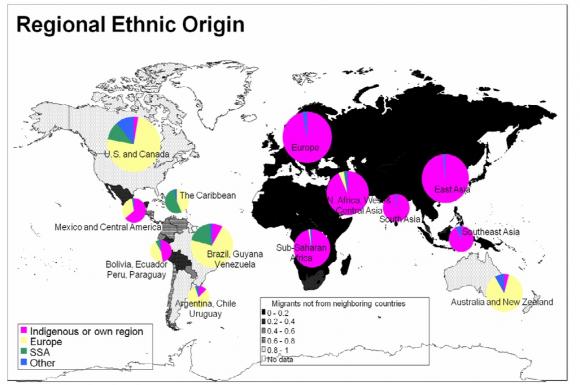PROVIDENCE, R.I. [Brown University] — Two Brown University economists have created a new data set explaining differences in the world’s current per capita gross domestic products (GDPs). In a National Bureau of Economic Research working paper, Louis Putterman and David N. Weil introduce a “World Migration Matrix” showing that inequality among countries can be largely explained by where the ancestors of each country’s people lived some 500 years ago. “What matters is the history of the people who live in a country today, more than the history of the country itself,” they say.
The World Migration Matrix is some of the first economic growth data to account for great population movements of the last half-millennium. For 165 countries, the matrix identifies where the ancestors of the permanent residents were living in the year 1500. The data illustrates how today’s countries are extremely diverse in terms of immigration. For example, the fraction of ancestors for today’s population who lived in their present country in 1500 is:
- 3 percent for the United States, Canadia, Australia, and New Zealand;
- 94 to 98 percent for Southeast Asia, South Asia, and East Asia;
- 94 percent for Europe;
- 89 percent for North Africa and West and Central Asia;
- 65 percent for Mexico and Central America;
- 20 percent for South America;
- 0 percent for the Caribbean.
When Putterman and Weil used the matrix to investigate the effects of the post-1500 population movements on income differences today, the results were “almost breathtaking.” The power of regional origins is illustrated by the fact that in a 125-country regression, 44 percent of the variance in current per capita GDP is accounted for by entering only the share of the population’s ancestors that lived in Europe in 1500.
Putterman and Weil say their findings are in line with other studies that find centuries-long persistence in the impact of other growth determinants, including the long-standing presence of state-level polities, the early transition to agriculture, and early advancement with respect to technologies like writing and number systems. But when Putterman and Weil examine these early indicators — then adjust for the origin of nations’ current populations — the impact on today’s incomes becomes even stronger.
More precisely, state history and year of agricultural transition explain less than 10 percent of the variance in today’s country incomes; corrected for post-1500 population shifts, either variable can explain about a quarter of that variance. Accounting for population origins in those countries having large non-indigenous population shares, like the countries of the Americas, Oceania, Taiwan and Singapore, provides a substantially more accurate window into the persistence of past advantages.
The research builds on work published by Putterman this month in Economica, asserting that early agriculture development has long-term consequences on a country’s economic growth. In “Agriculture, Diffusion and Development: Ripple Effects of the Neolithic Revolution,” Putterman created new, country-specific estimates of the timing of agricultural transition for 160 counties, the oldest dating back 10,500 years (Jordan and Israel). He demonstrated tht the number of years since a society made the transition from hunting and gathering to agriculture is highly correlated to the level of income in the country today. That is, the earlier the agriculture development, the higher the income.
But as Putterman and Weil’s later work shows, history’s influence on economic capabilities is not limited to the locations in which innovations first took place because technologies and social capabilities can be transferred from one place to another — including by migrations such as those that have remade the globe since the 15th-century encounter between the Old and New worlds.
Putterman and Weil reflect on the implications of this work in a column on Voxeu.org, a Web site featuring research-based policy analysis and commentary from leading economists:
“First, if this influence is indeed as significant as our findings suggest it to be, then efforts to sort out the roles that geographic, institutional, and other factors play in explaining income levels and growth rates may produce misleading results unless we properly control for it.
“Second, the influence of population origins suggests that there is something that human families and communities transmit from generation to generation — perhaps a form of economic culture, a set of attitudes or beliefs, or informally transmitted capabilities — that is of at least similar importance to economic success as are more widely recognized factors like quantities of physical capital and even human capital in the narrower sense of formal schooling. If we understand which culturally transmitted factors are important and what contributes to their emergence and propagation, we might be able to design policy interventions that could help less successful groups and countries to close their developmental gaps.”
Putterman and Weil are both professors of economics at Brown University. Weil is also a research associate of the National Bureau of Economic Research and Brown’s Population Studies Training Center, and Putterman is a faculty associate of Brown’s Watson Institute for International Studies.

